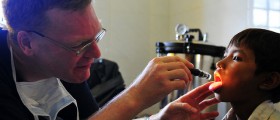
Tourette syndrome is a condition which can also be referred to as the Tourette's disorder, Gilles de Tourette etc. Basically, it is an inherited neuropsychiatric disorder which initially appears in childhood, manifesting through multiple physical and motor tics, with at least a single vocal tic. Therefore, Tourette's syndrome is considered to be a tic disorder which encompasses several types of tics taking place at once. Some of these tics are transient while some remain chronic.
The media have presented this health issue in a wrong context, commonly presenting people with Tourette syndrome yelling out swearwords and other inappropriate language out loud without being able to control these occurrences. However, these cases are extremely rare and most of the sufferers do not exclaim obscene words even though they suffer from Tourette's syndrome, which, on the other hand, is no longer considered to be a rare condition.
Today, about 1 in every 1,000 children suffer from Tourette's, while 10 in every 1,000 people have some forms of tic disorders. Tourette's is not related to sex, social background or any other factors of this type and may affect any possible individual.
Classification
The main definition of tics would be sudden, repetitive and stereotyped movements which manifest in a specific rhythmic occurrence if they are motor or through vocal utterance if they are phonic. The phonic tics may manifest through the mouth, nose or throat.
Depending on the types of tics bothering a person, the combinations of them may present a different type of condition – the above mentioned Tourette syndrome. This condition is diagnosed once several motor tics and at least a single phonic tic affect a person for more than a year.
Regardless of the fact that Tourette syndrome encompasses tics which are more prominent than most, the manifestations of tic in people who suffer from this condition are usually quite mild. In fact, many times, Tourette syndrome goes by undetected, appearing for a while and disappearing afterwards, leaving people unaware of its presence.
Eye blinking and throat clearing are the most common tics related to the Tourette syndrome and only in 10% of all cases do people actually utter certain words during tic manifestations.
Causes and Diagnosis
If a person suffers from Tourette syndrome, the chances of him/her transferring the condition onto his/her child are 50%. Yet, not every person who inherits the genes behind the syndrome will actually experience tics or show all the symptoms necessary for the diagnosis of this condition. Even though there are no fixed rules when it comes to genetic vulnerability to Tourette syndrome, males seem to be more commonly affected by it than women, at least when it comes to actually expressing the tics.
Sometimes, some other, non-genetic factors may lead to the onset of the symptoms of this syndrome. These factors are psychosocial, environmental and infectious. Therefore, certain situations may lead to the worsening or the initial appearance of the symptoms, mainly due to specific changes in the brain. However, the scientists are yet to completely understand the etiology related to this condition and tics in general.
Nevertheless, some cases of OCD were directly connected with Tourette syndrome, while this was also the case with ADHD, even though the occurrences of both ADHD and Tourette syndrome are not so common.
As for the diagnosis of this condition, the process takes place once a single person has shown multiple tics of the motor type, appearing with at least a single one of phonic type, continually, over a period of a year, without being free from symptoms for more than 3 months. The initial symptoms need to appear before the sufferer reaches the 18th age of life. Also, the condition cannot have any connections with the effects of certain substances or some other general medical conditions. Therefore, all patients who undergo Tourette syndrome diagnosis need to be free from autism or some other forms of tic disorders.
All in all, there are no specific tests which can provide proof regarding the present of Tourette syndrome in one's life. Due to these factors, this condition is commonly overlooked or even misdiagnosed, especially when it comes to coughing, eye blinking and some tics which may mislead health experts into diagnosing asthma or some other, absent, conditions. However, if the disorder has been running in the family of a person and the person him/herself is showing the adequate symptoms necessary for the diagnosis, a simple physical and neurological testing may be enough.
If OCD or ADHD are present too, this needs to be adequately diagnosed and separated from the symptoms related to Tourette syndrome in a patient.
Management
Initially, clonidine is the medication used for supressing the symptoms of Tourette syndrome. However, many times, reassurance, education or some forms of behavioral therapy may be enough for dealing with milder cases of this condition. Yet, there is no specific cure for Tourette syndrome and most approaches give their best to help the sufferer overcome this condition by learning how to suppress the symptoms.
Alternatively, the pharmacological treatment may involve haloperidol or risperidone, as well as some stimulants or antidepressants. Nevertheless, cognitive behavioral therapy, yoga or some other relaxations techniques have proven to be quite effective too.
To sum up, Tourette syndrome is a condition manifesting through several different types of tics, affecting the same person. The tics need to be motor with at least a single phonic one. Even though there is no cure for this genetically inherited condition, several types of treatment may help a person to manage the symptoms successfully.






_f_280x120.jpg)










Your thoughts on this
Loading...